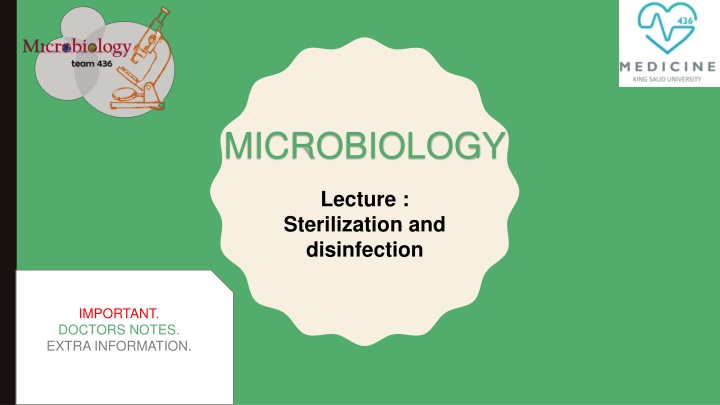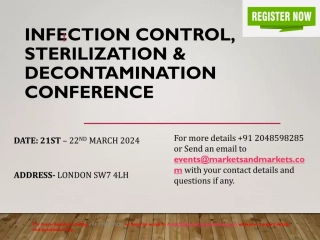Essential Concepts in Sterilization and Disinfection Practices
Understanding the principles of sterilization and disinfection is crucial in medical settings. This lecture covers topics such as defining sterilization, disinfectants, and antiseptics, different methods of sterilization (physical and chemical), the significance of heat sterilization, dry and moist heat applications, autoclave function, non-heat sterilization methods, and distinctions between antiseptics and disinfectants. Explore the importance of various disinfection and antiseptic techniques in medical applications.
Download Presentation

Please find below an Image/Link to download the presentation.
The content on the website is provided AS IS for your information and personal use only. It may not be sold, licensed, or shared on other websites without obtaining consent from the author.If you encounter any issues during the download, it is possible that the publisher has removed the file from their server.
You are allowed to download the files provided on this website for personal or commercial use, subject to the condition that they are used lawfully. All files are the property of their respective owners.
The content on the website is provided AS IS for your information and personal use only. It may not be sold, licensed, or shared on other websites without obtaining consent from the author.
E N D
Presentation Transcript
MICROBIOLOGY Lecture : Sterilization and disinfection IMPORTANT. DOCTORS NOTES. EXTRA INFORMATION.
Objectives : 1- Define the terms sterilization, disinfectant and antiseptic. 3 2- Classify the different methods of sterilization (physical and chemical methods). 4 3- Know and realizes that heat is the most important method of sterilization and its application in medical practice. 5 4- Know dry heat as applied in hot air Oven and moist heat as applied in autoclaves. 7 5- Know the principles of Autoclave function and monitoring methods of sterilization .6-9 6- Know the importance of non heat sterilization methods and their use for sterilization of heat sensitive objects. 13-15 7-Know the difference between antiseptics and disinfectants. 16 8- Know types and scope of function of the disinfectants and antiseptics and factors affecting their functions. 16 9- Know the medical applications of different disinfections and antiseptics. 16
Definition complete killing of all forms of microorganisms, including bacterial spores. Sterilization: Disinfection: killing or removing of harmful vegetative microorganisms. chemical substance used to achieve disinfection. Disinfectant: Antiseptic: disinfectant that can be safely used on living tissues.
Methods of Sterilization Physical methods: Chemical method: (used for heat sensitive equipments) dry heat moist heat 1. 2. 3. 4. Heat U.V. Light Ionizing Radiation Filtration 1. 2. EthyleneOxide Gluteraldehyde Simplest methods is to sterilize by naked flame
PHYSICAL METHODS HEAT Most important should be used whenever possible types: B- A- Moist heateg. Autoclave at 121 or 134 C for 10 or 15 minutes Dry heat at temperature of 160 C for one hour
PHYSICAL METHODS : Sterilization by Heat (Common methods) A) Dry Heat: Dry Heat- kills microorganisms by destroying their oxidative processes. -Simplest method is exposing item to be sterilized to the naked flame e.g. Bunsen burner- for sterilizing bacteriological loops, knives, blades. -Hot air oven expose items to 160 C for 1 hour. Has electric element in chamber as source of heat plus a fan to circulate air for even distribution of heat in chamber. Oven without fan is dangerous. Used for items that are lacking water such as: http://t0.gstatic.com/images?q=tbn:dNI8EWwQs12WjM:http://www.lifelinemedical.net/_images/manautoclave-01b.jpg -Metals -Glassware -Ointment / Oils/ Waxes /Powder
B) Moist Heat very important Uses hot water. Moist heat kills microorganisms by denaturating proteins. Autoclaving standard sterilization method in hospitals (standard method) . The equipment is called Autoclave and it works under the same principle as the pressure cooker ( ) where water boils at increased atmosphere pressure i.e. because of increase pressure the boiling point of water is >100 C. The autoclave is a tough double walled chamber in which air is replaced by pure saturated steam under pressure. autoclave spores http://t1.gstatic.com/images?q=tbn:y8mNYJ04N1XtxM:http://img.directindustry.com/images_di/photo-g/laboratory-autoclave-with-hydraulic-door-305058.jpg http://t0.gstatic.com/images?q=tbn:_7dcwyvnfhz3jM:http://www.supplierlist.com/photo_images/70930/12L_Simple_Autoclave.jpg Go to fullsize image
B) Moist Heat The air in the chamber is evacuated and filled with saturated steam. The chamber is closed tightly the steam keeps on filling into it and the pressure gradually increases. The items to be sterilized get completely surrounded by saturated steam (moist heat) which on contact with the surface of material to be sterilized condenses to release its latent heat of condensation which adds to already raised temperature of steam so that eventually all the microorganisms in what ever form are killed. The usual temperature achieved is 121 C , exposure time of only 15 minutes ( or 134 C for 10 minutes).
Advantages of Autoclave Monitoring of Autoclaves 1. Physical method: use of thermocouple to measure accurately the temperature. 1. Temp. > 100 C therefore spores killed. 2. Condensation of steam generates extra heat. 3. The condensation also allows the steam to penetrate rapidly into porous materials. Note: for all invasive procedures at operating room or clinics, autoclavable equipments should be used. 2. Chemical method: it consists of heat sensitive chemical that changes color at the right temperature and exposure time. e.g. a)- Autoclave tape b)- Browne s tube. 3. Biological method: where a spore- bearing organism is added during the sterilization process and then cultured later to ensure that it has been killed. autoclaves 3
Moist heat: Other Applications Pasteurization Used heat at temperatures sufficient to inactivate harmful organism in milk. The temperatures of sterilization is not achieved . Temperature may be 74 C, for 3-5 seconds. ( Flash methods ) or 62 C for 30 minutes. ( Conventional method ). Pasteurization of the milk to prevent diseases like : Typhoid fever Brucellosis Tuberculosis Q fever Salmonella Boiling quite common especially in domestic circumstances.
Other physical methods Radiation Filtration Ionizing radiation- e.g. Gamma radiation: has greater energy than U.V. light, therefore more effective. Used mainly in industrial facilities e.g. sterilization of disposable plastic syringes, gloves, specimens containers and Petri dishes. Use of membrane filter Example ; membrane filter made of cellulose acetate. Generally removes most bacteria but viruses and some small bacteria e.g. Chlamydia & Mycoplasma may pass through. Thus filtration does not technically sterilize items but is adequate for circumstances under which is used. Main use: for heat labile substances e.g. sera, antibiotics. Serum is sterilized by filtration U.V. light Has limited sterilizing power because of poor penetration into most materials. Generally used in irradiation of air in certain areas such as operating rooms and tuberculosis labs.
http://t3.gstatic.com/images?q=tbn:ULCXGhvYA4_e_M:http://www.appletonwoods.co.uk/acatalog/GC471.jpghttp://t3.gstatic.com/images?q=tbn:ULCXGhvYA4_e_M:http://www.appletonwoods.co.uk/acatalog/GC471.jpg http://t0.gstatic.com/images?q=tbn:-fl8eKyMIEsIRM:http://image.tradevv.com/2009/07/24/newera1_432969_450/autoclave-tape.jpg Moist heat filtration http://t3.gstatic.com/images?q=tbn:Fo27iUeAdcieTM:http://www.duckol.com/uploadFiles/upimg26/Microfiltration-Membrane-Filters.jpg http://t1.gstatic.com/images?q=tbn:35FVmUfK3cURBM:http://images2.opticsplanet.com/640-640/opplanet-whatman-filter-holders-for-nuclepore-membrane-filters-whatman-420200.jpg http://t1.gstatic.com/images?q=tbn:4ZGd9vK2iMgHGM:http://www.trinityfiltration.in/images/membrane-filters.jpg http://t3.gstatic.com/images?q=tbn:wionk_8EKOMzXM:http://imghost1.indiamart.com/data2/YY/NJ/MY-1857873/membrane_pic-500x500-250x250.jpg
Chemical Methods: Used for heat sensitive equipments. e.g. plastics and lensed endoscopes. Simple Strong disinfectants / antiseptic chemical substances may be used to achieve sterilization ( kill spores) alcohol, phenolics, chlorhexidine, Activated alkaline Gluteraldehyde 2% ) Ethylene oxide Ethylene oxide (inactivates microorganisms by alkylates DNA molecules) ( Most disinfectant doesn t achieve full sterilize EXEPT glutaraldehyde 2% can achieve full sterilize Ethylene oxide may cause explosion if used pure, so it is: 1- mixed with an inert gas. 2- Requires high humidity (50- 60% ). 3- Temperature : 55-60 C 4- exposure period 4-6 hours. Immerse item (endoscopes) in solution (Gluteraldehyde) for: ^ ( ) HIV & hepatitis B/C virus ^ 1- HIV or hepatitis B/C < about 20 m. 2- Mycobacterium tuberculosis or spores < immersion period 2-3 h.
. 1-Activity directly proportional to temperature. FACTORS INFLUENCING ACTIVITY OF 2-Directly proportional to concentration up to a point optimum concentration. After this level no advantage in further increases in concentration. . ) ( ^ . ! 3- it is inactivated by: A-Dirt. B-Organic matter (Proteins, Pus, Blood, Mucus, Feces). C-Non organic (Cork ,Hard water, Some plastics). . ) ( )).. / / ( ^ 4- Time: Disinfectants need time to work (explosion). DISINFECTANTS Range of action means (affects what type of bacteria?) 5- Range of Action: Disinfectants not equally effective against the whole spectrum of microbes. e.g. Chlorhexidine: less active against (-Gram) bacteria than (+Gram) cocci. Hypochlorite & Gluteraldehyde: more active against hepatitis viruses than most other disinfectants.
Summary: Disinfectants /Antiseptics Grampositivecocci bacilli \ Gram negative Chlorine s uses include: -Clorox (diluted form) -small portions are added to drinking water -used in swimming pools (esspecially public ones) - + : effective ++: very effective - : Less effective : + - maybe = double negative (less effective) ^you should read all that , you are a doctor but you need to memorize only the strong Disinfectants (yellow) most of the strong disinfectants are ++ & daily-use Disinfectants (blue) most of the daily-use disinfectants ars - or = differ especially in spores
Hospital disinfection methods *Depends on Hospital s Policy Article -Floors, walls: -Surfaces tables: Disinfectant Phenolics fluids 1-2% Hypochlorite, Alcohol Gluteraldehyde 2% (Cidex) -Endoscopes: sub-atmospheric steam -Thermometers: Skin: -Surgeons hands: -Patient skin: 70% Alcohol Antiseptics Chlorhexidine, Iodine alcohol 70% Alcohol, Iodine
Important points Any instrument or item used for sterile body site should be sterile. Any instrument or item used for non-sterile body site can be disinfected. Hand washing is the most important to prevent hospital acquired infection. Online quiz https://www.onlineexambuilder.com/microbiology-l7- part2/exam-106383
summery U.V light Methods of sterilization Chemical(used for heat sensitive equipments) Physical Ionizig radiation Gluteraldehyde e.g. Gamma radiation Ethylene oxide Filtration Heat e.g. Membrane filter Dry Moist e.g. Bunsen burner autoclave
THE TEAM : THE TEAM : Contact us : Shrooq Alsomali Hanin Bashaikh Jawaher Alkhayyal Reem Alshathri Rawan Alqahtani Ohoud Abdullah Ghadah Almazrou Lama Al-musallam Waleed Aljamal Ibrahim Fetyani Meshal Eiaidi Khalid Alhusainan Hussam Alkhathlan Faisal Alqumaizi 436microbiologyteam@gmail.com Twitter : @microbio436























